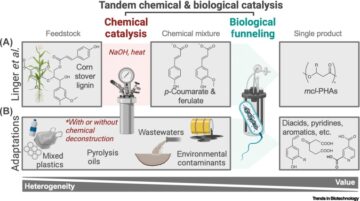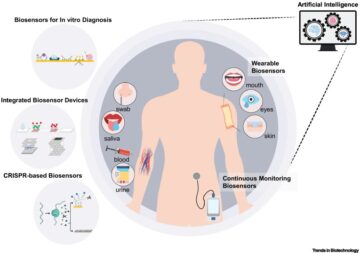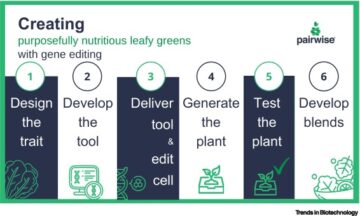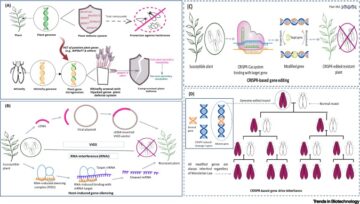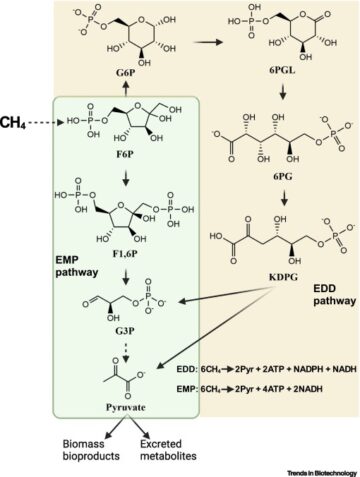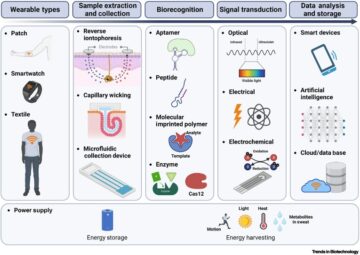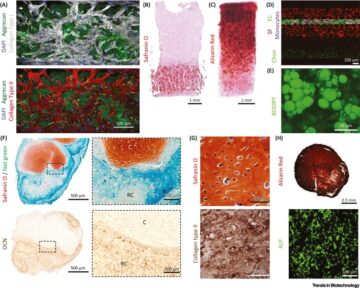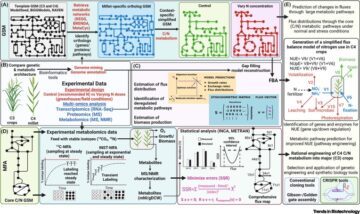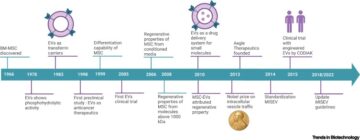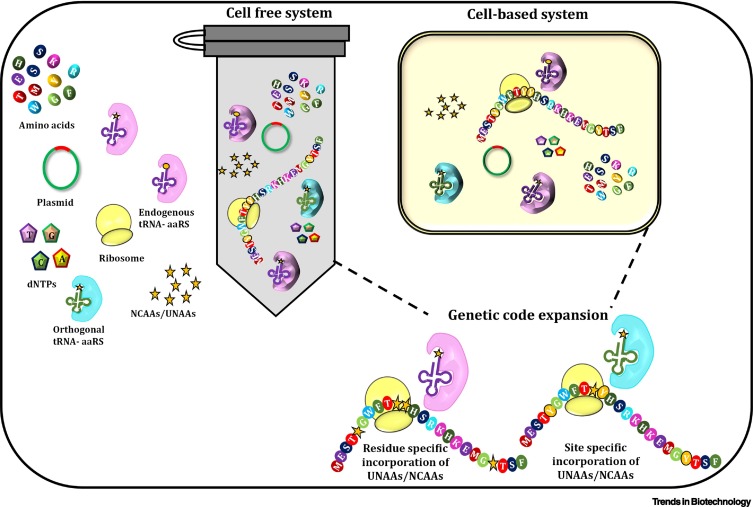
Amino acids: chemistry, functionality and selected non-enzymatic post-translational modifications.
J. Proteome. 2012; 75: 2275-2296
Photo-cleavable purification/protection handle assisted synthesis of giant modified proteins with tandem repeats.
Chem. Sci. 2019; 10: 8694
Mechanical properties of tandem-repeat proteins are governed by network defects.
ACS Biomater. Sci. Eng. 2018; 4: 884-891
Processing of collagen based biomaterials and the resulting materials properties.
Biomed. Eng. Online. 2019; 18: 24
A self-assembly and higher order structure forming triple helical protein as a novel biomaterial for cell proliferation.
Biomater. Sci. 2019; 7: 2191-2199
Overcoming challenges in engineering the genetic code.
J. Mol. Biol. 2016; 428: 1004-1021
A genetically encoded probe for imaging nascent and mature HA-tagged proteins in vivo.
Nat. Commun. 2019; 10: 2947
In vivo residue-specific DOPA-incorporated engineered mussel bioglue with enhanced adhesion and water resistance.
Angew. Chem. Int. Ed. Engl. 2014; 53: 13360-13364
Photoactivatable mussel-based underwater adhesive proteins by an expanded genetic code.
Chembiochem. 2017; 18: 1819-1823
Site-specific incorporation of unnatural amino acids into Escherichia coli recombinant protein: methodology development and recent achievement.
Biomolecules. 2019; 9: 255
Expanding and reprogramming the genetic code.
Nature. 2017; 550: 53-60
Learning from nature to expand the genetic code.
Trends Biotechnol. 2021; 39: 460-473
Rewriting the genetic code.
Annu. Rev. Microbiol. 2017; 71: 557-577
Organic fluorine as a polypeptide building element: In vivo expression of fluorinated peptides, proteins and proteomes.
Org. Biomol. Chem. 2012; 10: 7241-7261
Bioorthogonal elastin-like polypeptide scaffolds for immunoassay enhancement.
ACS Appl. Mater. Interfaces. 2018; 10: 30147-30154
Gradient nano-engineered in situ forming composite hydrogel for osteochondral regeneration.
Biomaterials. 2018; 162: 82-98
Injectable and 3D bioprinted polysaccharide hydrogels: from cartilage to osteochondral tissue engineering.
Biomacromolecules. 2017; 18: 1-26
Unhydroxylated triple helical collagen I produced in transgenic plants provides new clues on the role of hydroxyproline in collagen folding and fibril formation.
J. Biol. Chem. 2001; 276: 43693-43698
Expanding the genetic code for biological studies.
Chem. Biol. 2009; 16: 323-336
Rational and semirational protein design.
Methods Mol. Biol. 2018; 1685: 15-23
Protein conjugation with genetically encoded unnatural amino acids.
Curr. Opin. Chem. Biol. 2013; 17: 412-419
In vitro incorporation of nonnatural amino acids into protein using tRNA(Cys)-derived opal, ochre, and amber suppressor tRNAs.
RNA. 2010; 16: 1660-1672
Enzymatic aminoacylation of tRNA with unnatural amino acids.
Proc. Natl. Acad. Sci. U. S. A. 2006; 103: 4356-4361
Transferability of N-terminal mutations of pyrrolysyl-tRNA synthetase in one species to that in another species on unnatural amino acid incorporation efficiency.
Amino Acids. 2021; 53: 89-96
Encoding multiple unnatural amino acids via evolution of a quadruplet-decoding ribosome.
Nature. 2010; 464: 441-444
A facile system for genetic incorporation of two different noncanonical amino acids into one protein in Escherichia coli.
Angew. Chem. Int. Ed. Engl. 2010; 49: 3211-3214
Reprogramming the genetic code.
Nat. Rev. Genet. 2021; 22: 169-184
Rewriting the genetic code.
Science. 2021; 372: 1040-1041
Expanding the limits of the second genetic code with ribozymes.
Nat. Commun. 2019; 10: 5097
Methods to generate tissue-derived constructs for regenerative medicine applications.
Methods. 2020; 171: 3-10
Complicity of degradable polymers in health-care applications.
Mater. Today Chem. 2020; 16100236
Engineered biomaterials for in situ tissue regeneration.
Nat. Rev. Mater. 2020; 5: 686-705
Biomaterials and engineered microenvironments to control YAP/TAZ-dependent cell behaviour.
Nat. Mater. 2018; 17: 1063-1075
Natural biomacromolecule based composite scaffolds from silk fibroin, gelatin and chitosan toward tissue engineering applications.
Int. J. Biol. Macromol. 2020; 154: 1285-1294
Protein-engineered biomaterials: highly tunable tissue engineering scaffolds.
Tissue Eng. B Rev. 2010; 16: 285-293
Bioconjugation of L-3,4-dihydroxyphenylalanine containing protein with a polysaccharide.
Bioconjug. Chem. 2011; 22: 551-555
Engineering of a skin-fiber-opening enzyme for sulfide-free leather beam house operation through xenobiology.
Green Chem. 2019; 21: 2070-2081
Site-directed immobilization of BMP-2: two approaches for the production of innovative osteoinductive scaffolds.
Biomacromolecules. 2017; 18: 695-708
Photo-crosslinkable unnatural amino acids enable facile synthesis of thermoresponsive nano- to microgels of intrinsically disordered polypeptides.
Adv. Mater. 2018; 30: 1704878
Streptococcal Scl1 and Scl2 proteins form collagen-like triple helices.
J. Biol. Chem. 2002; 277: 27312-27318
Identification and characterization of a second extracellular collagen-like protein made by group A Streptococcus: control of production at the level of translation.
Infect. Immun. 2001; 69: 1729-1738
Self-association of Streptococcus pyogenes collagen-like constructs into higher order structures.
Protein Sci. 2009; 18: 1241-1251
Incorporation of hydroxyproline in bacterial collagen from Streptococcus pyogenes.
Acta Biomater. 2018; 80: 169-175
Growth factor-mimicking 3,4-dihydroxyphenylalanine-encoded bioartificial extracellular matrix like protein promotes wound closure and angiogenesis.
Biomater. Sci. 2020; 8: 6773-6785
Elastin-based materials.
Chem. Soc. Rev. 2010; 39: 3371-3379
Sensitive, site-specific, and stable vibrational probe of local protein environments: 4-azidomethyl-l-phenylalanine.
J. Phys. Chem. B. 2013; 117: 8987-8993
Evolution of translation machinery in recoded bacteria enables multi-site incorporation of nonstandard amino acids.
Nat. Biotechnol. 2015; 33: 1272-1279
Cell-free protein synthesis from genomically recoded bacteria enables multisite incorporation of noncanonical amino acids.
Nat. Commun. 2018; 9: 1203
A bioinspired elastin-based protein for a cytocompatible underwater adhesive.
Biomaterials. 2017; 124: 116-125
Lithographic patterning of photoreactive cell-adhesive proteins.
J. Am. Chem. Soc. 2007; 129: 4874-4875
Multiple site-selective insertions of noncanonical amino acids into sequence-repetitive polypeptides.
Chembiochem. 2013; 14: 968-978
Protein-engineered functional materials.
Adv. Healthc. Mater. 2019; 8e1801374
3,4-Dihydroxyphenylalanine (DOPA)-containing silk fibroin: its enzymatic synthesis and adhesion properties.
ACS Biomater. Sci. Eng. 2019; 5: 5644-5651
Genetic code expansion of the silkworm Bombyx mori to functionalize silk fiber.
ACS Synth. Biol. 2018; 7: 801-806
Antibiotic spider silk: site-specific functionalization of recombinant spider silk using ‘click’ chemistry.
Adv. Mater. 2017; 29: 11604245
Salt triggers the simple coacervation of an underwater adhesive when cations meet aromatic π electrons in seawater.
ACS Nano. 2017; 11: 6764-6772
Dueling backbones: comparing peptoid and peptide analogues of a mussel adhesive protein.
Macromolecules. 2020; 53: 6767-6779
Mussel adhesion-employed water-immiscible fluid bioadhesive for urinary fistula sealing.
Biomaterials. 2015; 72: 104-111
Comparison of natural extraction and recombinant mussel adhesive proteins approaches.
in: Puri M. Food Bioactives: Extraction and Biotechnology Applications. Springer International, 2017: 111-135
Enhanced production of DOPA-incorporated mussel adhesive protein using engineered translational machineries.
Biotechnol. Bioeng. 2020; 117: 1961-1969
Bio-orthogonal conjugation and enzymatically triggered release of proteins within multi-layered hydrogels.
Acta Biomater. 2017; 56: 80-90
Genetic code expansion enables site-specific pegylation of a human growth hormone receptor antagonist through click chemistry.
Bioconjug. Chem. 2020; 31: 2179-2190
Targeting interleukin-4 to the arthritic joint.
J. Control. Release. 2020; 326: 172-180
Specific labeling of zinc finger proteins using noncanonical amino acids and copper-free click chemistry.
Bioconjug. Chem. 2012; 23: 1891-1901
Engineering transaminase for stability enhancement and site-specific immobilization through multiple noncanonical amino acids incorporation.
ChemCatChem. 2015; 7: 417-421
Site-selective glycosylation of proteins: creating synthetic glycoproteins.
Nat. Protoc. 2007; 2: 3185-3194
Bio-orthogonal immobilization of fibroblast growth factor 2 for spatial controlled cell proliferation.
ACS Biomater. Sci. Eng. 2015; 1: 740-746
Click grafting of alkyne-containing vinyl polymers onto biosynthesized extracellular matrix protein containing azide functionality and adhesion control of human umbilical vein endothelial cells.
RCS Adv. 2015; 5: 41445-41456
Artificial extracellular matrix proteins containing phenylalanine analogues biosynthesized in bacteria using T7 expression system and the PEGylation.
Biomacromolecules. 2011; 12: 3444-3452
Site-specific incorporation of the mucin-type N-acetylgalactosamine-alpha-O-threonine into protein in Escherichia coli.
J. Am. Chem. Soc. 2004; 126: 15654-15655
In vivo double and triple labeling of proteins using synthetic amino acids.
Angew. Chem. Int. Ed. Engl. 2010; 49: 5446-5450
Genetic incorporation of unnatural amino acids into proteins in Mycobacterium tuberculosis.
PLoS One. 2010; 5e9354
Codon reassignment in the Escherichia coli genetic code.
Nucleic Acids Res. 2010; 38: 8188-8195
RF1 knockout allows ribosomal incorporation of unnatural amino acids at multiple sites.
Nat. Chem. Biol. 2011; 7: 779-786
Release factor one is nonessential in Escherichia coli.
ACS Chem. Biol. 2012; 7: 1337-1344
Genomically recoded organisms expand biological functions.
Science. 2013; 342: 357-360
Highly reproductive Escherichia coli cells with no specific assignment to the UAG codon.
Sci. Rep. 2015; 5: 9699
Reassignment of a rare sense codon to a non-canonical amino acid in Escherichia coli.
Nucleic Acids Res. 2015; 43: 8111-8122
A facile and efficient method for the incorporation of multiple unnatural amino acids into a single protein.
Chem. Commun. (Camb.). 2011; 47: 3430-3432
In vivo incorporation of multiple noncanonical amino acids into proteins.
Angew. Chem. Int. Ed. Engl. 2011; 50: 2896-2902
A 68-codon genetic code to incorporate four distinct non-canonical amino acids enabled by automated orthogonal mRNA design.
Nat. Chem. 2021; 13: 1110-1117
Toward an orthogonal central dogma.
Nat. Chem. Biol. 2018; 14: 103-106
Directed evolution of an improved aminoacyl-tRNA synthetase for incorporation of L-3,4-dihydroxyphenylalanine (L-DOPA).
Angew. Chem. Int. Ed. Engl. 2021; 60: 14811-14816
Enhanced cellular uptake and sustained transdermal delivery of collagen for skin regeneration.
ACS Appl. Bio Mater. 2020; 3: 7540-7549
Genetic code expansion: inception, development, commercialization.
J. Am. Chem. Soc. 2021; 143: 4859-4878
A facile strategy for selective incorporation of phosphoserine into histones.
Angew. Chem. Int. Ed. Engl. 2013; 52: 5771-5775
Chemoenzymatic synthesis of oligosaccharides and glycoproteins.
Trends Biochem. Sci. 2004; 29: 656-663
Biosynthetic substitution of tyrosine in green fluorescent protein with its surrogate fluorotyrosine in Escherichia coli.
Biotechnol. Lett. 2011; 33: 2201-2207
Esterification of polymeric carbohydrate through congener cutinase-like biocatalyst.
Appl. Biochem. Biotechnol. 2021; 193: 19-32
Excited state electronic interconversion and structural transformation of engineered red-emitting green fluorescent protein mutant.
J. Phys. Chem. B. 2019; 123: 2316-2324
Evaluation and biosynthetic incorporation of chlorotyrosine into recombinant proteins.
Biotechnol. Bioprocess Eng. 2012; 17: 679
Global incorporation of norleucine in place of methionine in cytochrome P450 BM-3 heme domain increases peroxygenase activity.
Biotechnol. Bioeng. 2003; 83: 729-734
Enhancing the biophysical properties of mRFP1 through incorporation of fluoroproline.
Biochem. Biophys. Res. Commun. 2013; 440: 509-514
Improving nature’s enzyme active site with genetically encoded unnatural amino acids.
J. Am. Chem. Soc. 2006; 128: 11124-11127
Novel mussel-inspired universal surface functionalization strategy: protein-based coating with residue-specific post-translational modification in vivo.
ACS Appl. Mater. Interfaces. 2019; 11: 12846-12853
Overview of cell-free protein synthesis: historic landmarks, commercial systems, and expanding applications.
Curr. Protoc. Mol. Biol. 2014; 108: 16.30.1-11
Engineering posttranslational proofreading to discriminate nonstandard amino acids.
Proc. Natl. Acad. Sci. U. S. A. 2018; 115: 619-624
An expanded eukaryotic genetic code.
Science. 2003; 301: 964-967
Genetically encoded alkenes in yeast.
Angew. Chem. Int. Ed. Engl. 2010; 49: 935-937
Global incorporation of unnatural amino acids in Escherichia coli.
Methods Mol. Biol. 2007; 352: 23-34
Non-standard genetic codes define new concepts for protein engineering.
Life (Basel). 2015; 5: 1610-1628
A fully orthogonal system for protein synthesis in bacterial cells.
Nat. Commun. 2020; 11: 1858
The pyrrolysine translational machinery as a genetic-code expansion tool.
Curr. Opin. Chem. Biol. 2011; 15: 387-391
Expanding and reprogramming the genetic code of cells and animals.
Annu. Rev. Biochem. 2014; 83: 379-408
The pyrrolysyl-tRNA synthetase activity can be improved by a P188 mutation that stabilizes the full-length enzyme.
J. Mol. Biol. 2022; 434167453
Sense codon emancipation for proteome-wide incorporation of noncanonical amino acids: rare isoleucine codon AUA as a target for genetic code expansion.
FEMS Microbiol. Lett. 2014; 351: 133-144
Towards reassigning the rare AGG codon in Escherichia coli.
Chembiochem. 2014; 15: 1750-1754
An expanded genetic code in mammalian cells with a functional quadruplet codon.
ACS Chem. Biol. 2013; 8: 1640-1645
Complex microparticle architectures from stimuli-responsive intrinsically disordered proteins.
Nat. Commun. 2020; 11: 1342
A general approach for the generation of orthogonal tRNAs.
Chem. Biol. 2001; 8: 883-890
- SEO Powered Content & PR Distribution. Get Amplified Today.
- Platoblockchain. Web3 Metaverse Intelligence. Knowledge Amplified. Access Here.
- Source: https://www.cell.com/trends/biotechnology/fulltext/S0167-7799(22)00172-X?rss=yes
- 1
- 3d
- a
- achievement
- active
- activity
- allows
- amber
- and
- animals
- Another
- applications
- approach
- approaches
- authors
- Automated
- Bacteria
- based
- Beam
- Biomaterials
- biotechnology
- Building
- Cells
- central
- challenges
- chemistry
- closure
- code
- commercial
- commercialization
- comparing
- concepts
- control
- controlled
- Creating
- delivery
- Design
- Development
- different
- distinct
- domain
- double
- ed
- efficiency
- efficient
- Electronic
- electrons
- enable
- enabled
- enables
- Engineering
- enhanced
- environments
- evolution
- Expand
- expanded
- expanding
- expansion
- extraction
- form
- formation
- from
- fully
- functional
- functionality
- functions
- General
- generate
- generation
- giant
- Green
- Group
- Growth
- handle
- higher
- highly
- historic
- House
- HTTPS
- human
- Imaging
- improved
- in
- inception
- incorporate
- Increases
- innovative
- interfaces
- labeling
- Level
- limits
- List
- local
- machinery
- made
- materials
- Matrix
- mature
- medicine
- Meet
- method
- Methodology
- Modifications
- modified
- MOL
- mRNA
- multi-layered
- multiple
- Mutation
- nano
- nascent
- Natural
- Nature
- network
- New
- novel
- ONE
- online
- operation
- order
- Place
- plants
- plato
- Plato Data Intelligence
- PlatoData
- Polymers
- probe
- Produced
- Production
- promotes
- properties
- Protein
- Proteins
- provides
- RARE
- recent
- regenerative
- release
- Resistance
- resulting
- Role
- SCI
- Second
- selected
- selective
- sense
- silk
- Simple
- single
- site
- Sites
- Skin
- Spatial
- specific
- Spider Silk
- Stability
- stable
- State
- Strategy
- structural
- structure
- studies
- Surface
- synthetic
- system
- Systems
- Tandem
- Target
- The
- Through
- to
- today
- tool
- toward
- Transformation
- Translation
- triggered
- Triple
- underwater
- Universal
- via
- vinyl
- vivo
- W
- Water
- within
- X
- zephyrnet

